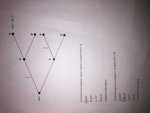...or I can spend the less than 30 seconds it takes rotate the image in MS Paint myself. That's always an option.
As for the actual problem itself, since you say you're uncertain of how you got these answers, it's probably best to start at the very beginning. I think a good first step would be to fill in the missing information in the tree diagram. You're given that the probability of event A happening is 1/3. So, what is the probability of event A not happening? Proceeding along the top branch of thr tree, the next piece of information tells you that \(\displaystyle P(A\cap B)=\dfrac{1}{7}\). In words, this means "the probability of A and B is 1/7." So what does that make the probability of B happening if A happens? What, then, is the probability of B not happening, given that A does? You're also given the probability of B happening if A doesn't. Is that probability the same as the probability of B happening if A does happen? What can you infer from that? What must the probability be of B not happening given A doesn't happen?
Now you can begin solving the problems. The first question asks you to compute \(\displaystyle P(B \vert A)\). In words, that means "the probability of B, given A." Based on the work you did above, what do you think the answer to this question is? Does it match one of the multiple choice options? If not, you'll need to go back to the tree diagram and revisit your answers there. The second question asks you to computer \(\displaystyle P(A \vert B)\). In words, that means "the probability of A, given B." This is trickier, and you can't just copy a particular answer from the diagram. Instead, here, you'll want to use Bayes' Theorem. Bayes' Theorem says that:
\(\displaystyle P\left(A|B\right)=\dfrac{P\left(B|A\right)\cdot P\left(A\right)}{P\left(B|A\right)\cdot P\left(A\right)+P\left(B|\neg A\right)\cdot P\left(\neg A\right)}\)
In this case, \(\displaystyle \neg A\) symbol means "not A" or "the probability of A not happening." You should know all of the values, so what happens when you plug them in and simplify? Do you get one of the multiple choice answers? If not, double check your math or revisit the tree diagram to ensure you have the correct values.

